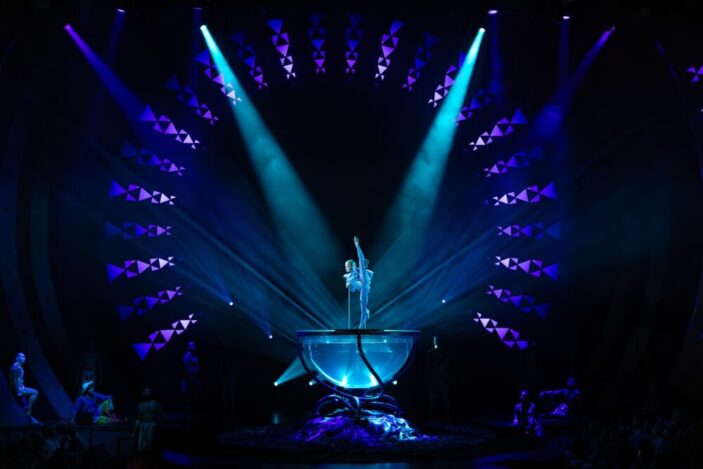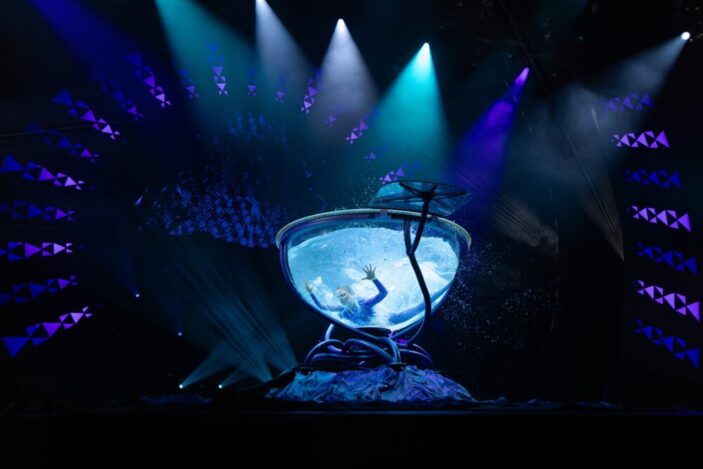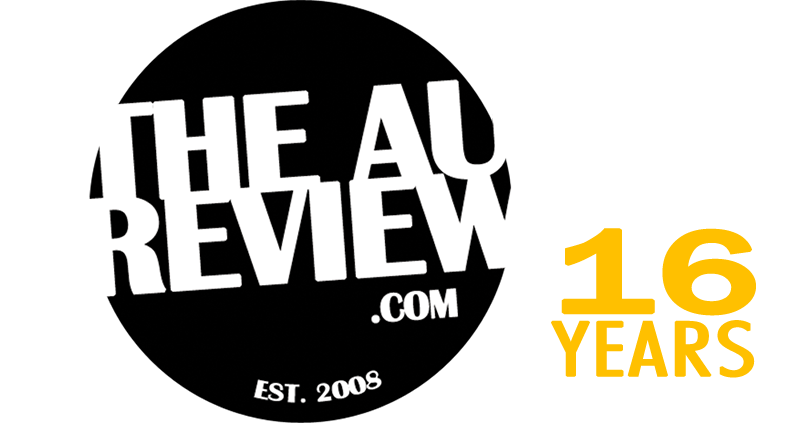
Earlier this month, I had the privilege of seeing the incredible new Cirque du Soleil production ‘Auana. Before I was able to sit in the Honolulu theatre and experience the city’s first ever Cirque residency, I sat down with one of the show’s performers, Anna Ivaseva.
Ivaseva brings her skills in the water bowl to Honolulu, something she’d previously shown off in the touring show Amaluna and Zumanity in Las Vegas (RIP). We spoke about the differences between touring with Cirque and performing with a residency.
How long have you been in Hawaii preparing for this production?
Three months.
And before then where were you training?
Las Vegas. That’s where we’re based my family and I had been based.
How’s the move been for you down here?
It’s been challenging. It’s been amazing. We love Hawaii. We always dreamed of living by the ocean, my husband and I. But it was a lot, I’m not gonna lie. We had to move two cars. Two dogs. Rent a house. In Las Vegas where we lived, had to say goodbye to our community and friends of course. So it’s a mixture of feelings. But it’s been amazing.
The Water Bowl act we see in ‘Auana has its origins from your time in the Cirque’s touring production Amaluna. How did you come to be involved in this show, and talk me through the evolution of that act to what we see now in Honolulu?
So I joined Cirque on 2013, in a show called Quidam as a Banquine Flyer. It’s like a big group act where they throw small girls around *laughs*. Then I always dreamed about being a soloist and I loved hand balancing. Um, when I joined Cirque, The Amaluna creation was actually happening, and I saw the Water Bowl on YouTube, and I was like, “wow”… but to me, it didn’t seem like an achievable goal, a dream. So I worked in Quidam for four years. Then I start training hand balancing, meanwhile. And then the show was closing in February 2016, and then Cirque was very generous to offer me a training contract to go back to the Kiev Circus School to switch the disciplines from being a flyer, to being a hand balancer.
And so, I joined Amaluna a year later. It was a year of training and injury, but I did make it to Amaluna eventually. So it was a long journey. It was amazing, challenging, but super grateful.
I met my husband while doing Quidam, and after touring for a while, we decided to settle down and start a family. And Vegas was the place to do that. So after two years in Amaluna, I transferred to Las Vegas to bring my act to (the residency) Zumanity.
The the pandemic happened, and baby happened. After that, I worked in a smaller production for almost three years. It was my first time working not working for Cirque. It was still hand balancing, but more of a cabaret show. Very different style, but it was very, very fun. And perfect for being a fresh Mum, the hours were perfect. Then I got an offer to ‘Auana. And when I saw the email, I was like, there’s no way they’ll take this blonde, white woman to the show about Hawaii. And I got a confirmation on my birthday. It was Sunday. I didn’t expect any emails. And it was Sunday and my parents were visiting from Russia. And I got an email that I got selected. It was amazing.

Is there an audition process that you go through, or because you’d already been part of Cirque…?
Yeah, not quite, because it’s very specific and, I think given the history of my work and the shows I’ve done. Of course, I always upload new videos and try to upgrade my profile and make sure it’s up to date with the latest videos of my work. But no audition. I did audition like many years ago.
And how has the your act transformed for this show? Tell me about who you’re playing in the cast. I understand, for all the acts here, bringing in references to Hawaiian culture, has been at the forefront of this production.
Yeah, absolutely. It’s been amazing to to work with the cultural team, and learn about Hawaiian history. We’ve done some things that were very meaningful for us. We did a kapu kai ceremony and went to Bishop Museum and talked a lot about history and I did my own work. But I think most of it came from our dressing room, the girls, the hula girls. They’ve been like, amazing and educating us about the culture and the traditions and they’re always open if we have any questions.
And then yes, my character for ‘Auana is Mamala surf-rider, she’s a half lizard, half human.
There’s a lot of information that is different, but when we went to Bishop Museum, our tour guide was referring to Mamala, who was a half shark and half woman. She’s a shape-shifter and she lives in the harbor. She protects the ocean, and she’s soft and kind and moves well. But then she’ll also be very angry if you weren’t nice to the ocean or to her. You don’t want to mess with Mother Nature. And that’s what I think about when when I perform the act, it helps me to get a character.
It was a great process with our choreographer and the cultural team and the costume designer to come up with that version of Mamala.
The costumes, across all Cirque productions, are as impressive as the performers and the wizardry on the stage. How much work goes into getting into that costume each night?
It’s a process. It’s beautiful. I love the design of it. It’s always challenging to find that balance of being respectful of keeping the integrity of the costume designer, but also making it comfortable for an acrobat to do what we have to do.
I’m guessing there’s many months of fittings and changes.
It’s still in process. Yeah, it’s still in process of making it exact, to satisfy everyone. So, but it’s good. I have an amazing team of wardrobe that always helped me, you know.
Can you talk me through the day-to-day of a show like this? And how does it compare to what it was like when you took a Cirque show on the road?
It’s hard to live out of suitcase on tour. You feel like you’re not living a real life. But it’s easier, because all you focus on is that show. On work. Maybe the days are a bit longer on tour. But you wake up. And you work. Then here (when you’re performing in a residency), you have life before you go and get to work. But it’s hard for me to compare because I on tour, I didn’t have a child. Now, I do have one and my days are very different.
So by the time I get to work, I’m tired. It depends on the day, it depends if I had training on stage, how I’m feeling, or if it’s towards the end of the week, or beginning of the week. Either I come to work and I do some workout… or I don’t, I just get straight to the makeup and then I do a warm-up.
And then between the (two nightly) shows, a little rest, snack. We’re training together with some people who wants to learn handstand. Or I’ll read a book. And then repeat, repeat it all over.
You’ve been on stage here now for a few weeks. How have you been enjoying the show? Not just being in it, but witnessing it as well?
Yeah, I have. Especially during creation. Now the show, when it starts, it’s quite fast, at least for me. There’s not a lot of down time, but I watch on the screen. I think the music and dancers make the show. You know, acrobats are amazing. But that’s what makes a show. It’s my favourite.
I was told by the show’s director, Neil Dorward, how much attention was paid to the music… bringing the Hawaiian language into it.
Yeah. The first time I heard the music, especially the opening scene, I was so embarrassed, I couldn’t stop crying. I was like, why? It got very emotional. I love the music, every single song.
I mean you’d spent months also learning about Hawaiian culture, so I can understand the power of that.
Of course. And I still am learning.
Were you familiar with hula before you came here?
No. Never. I mean, as soon as I signed the contract, me and my husband found YouTube videos. We started really learning. We were nervous coming coming here, we want to be respectful. We’re guests. And all of the hula dancers (in the show) are amazing.
As we’re about to experience the show for the first time ourselves tonight, what do you hope people take away from the show? Both on a whole and from your performance.
I hope they become curious. If they’re not from Hawaii, just visiting. I hope they’re curious and maybe they later on they can research and be inspired to learn a little bit more. About the history and the culture. And I hope they can forget the problems of the day and like just disappear the magic world. Just watch and enjoy and maybe be inspired in different ways, you know?
Well, few do magic worlds better than Cirque. Thank you very much for your time.
‘Auana enjoys 10 weekly performances – Wednesdays to Sundays at 5.30pm and 8.30pm – at the Waikiki Beachcomber by Outrigger.
For tickets and more details head to the official website HERE.
